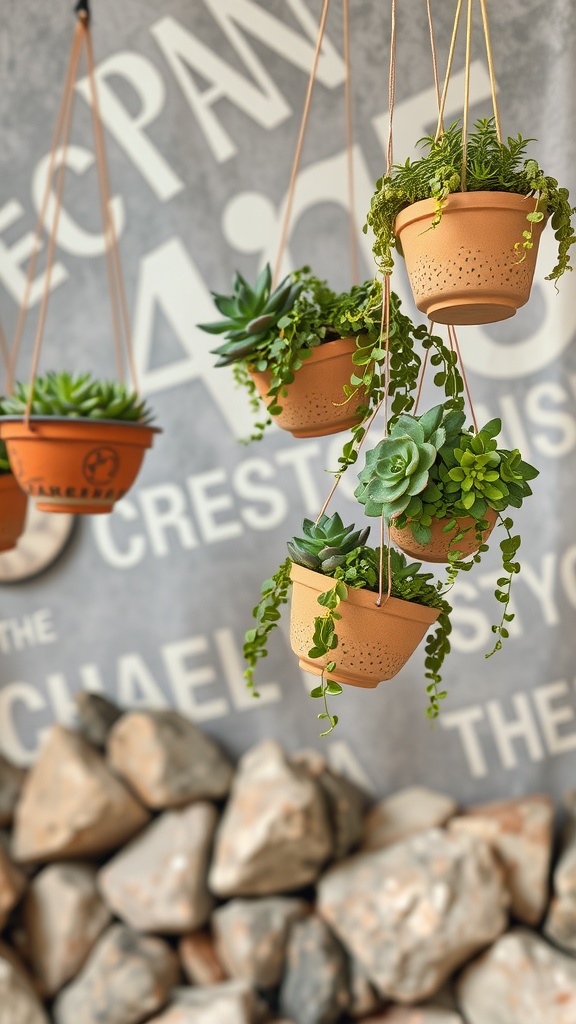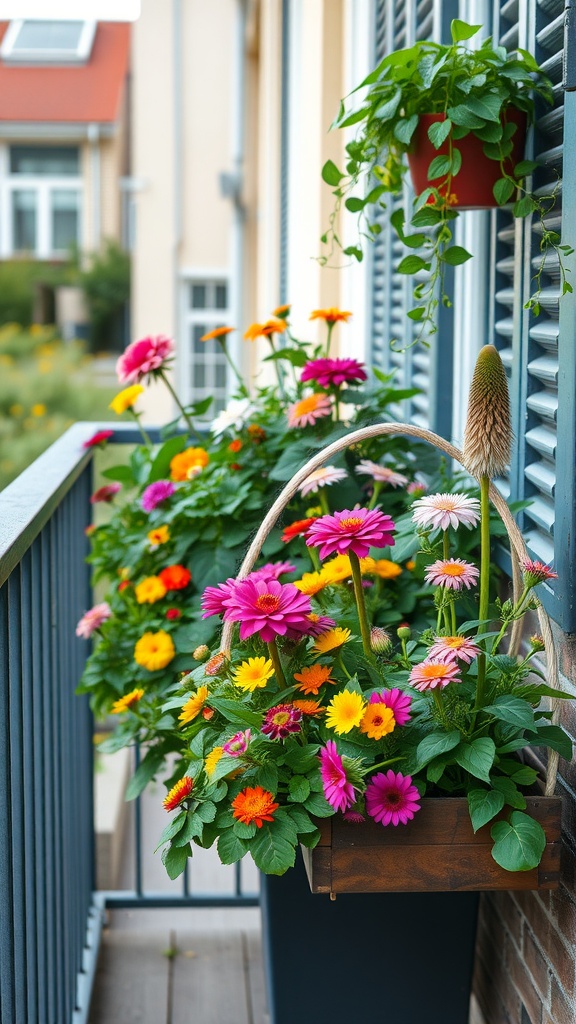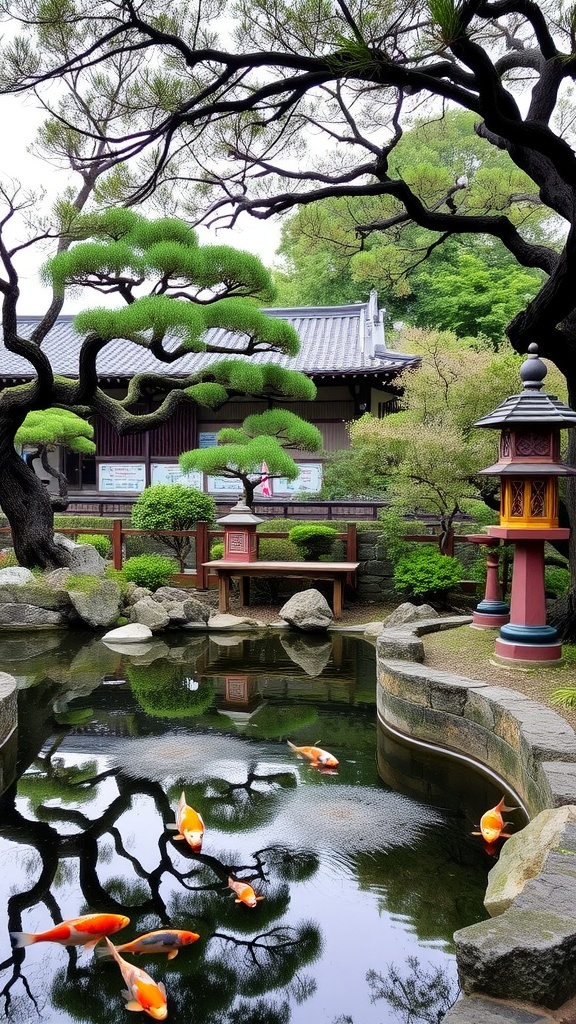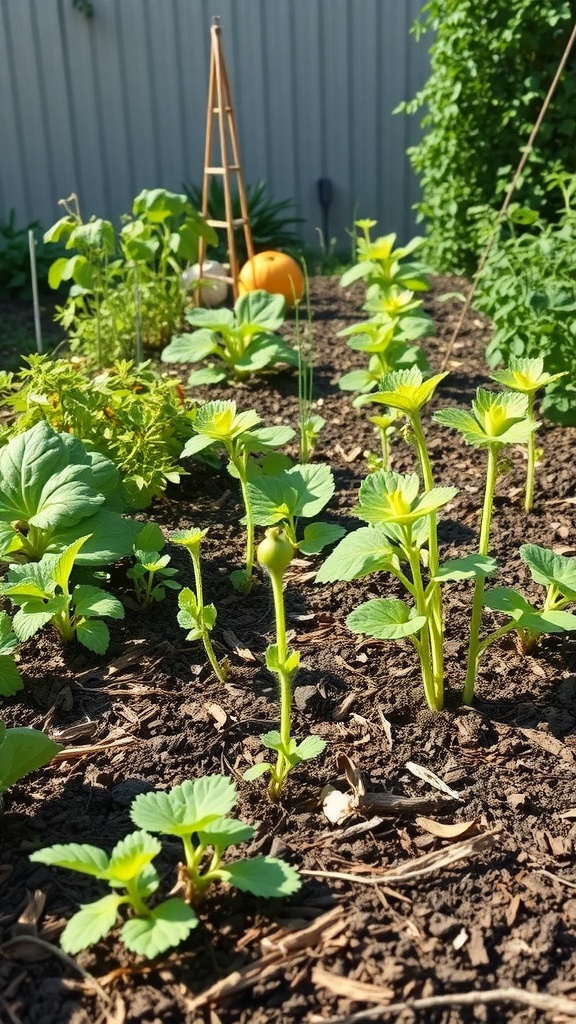If you’re itching to get your hands dirty and grow your own veggies or flowers, you’re in luck! Here are 27 creative layouts for raised garden beds that can help you maximize your space while giving your garden a unique flair. From compact designs to sprawling arrangements, there’s plenty of inspiration here for every gardener, no matter your style or setup. Let’s dig in!
Vertical Raised Garden Beds for Small Spaces
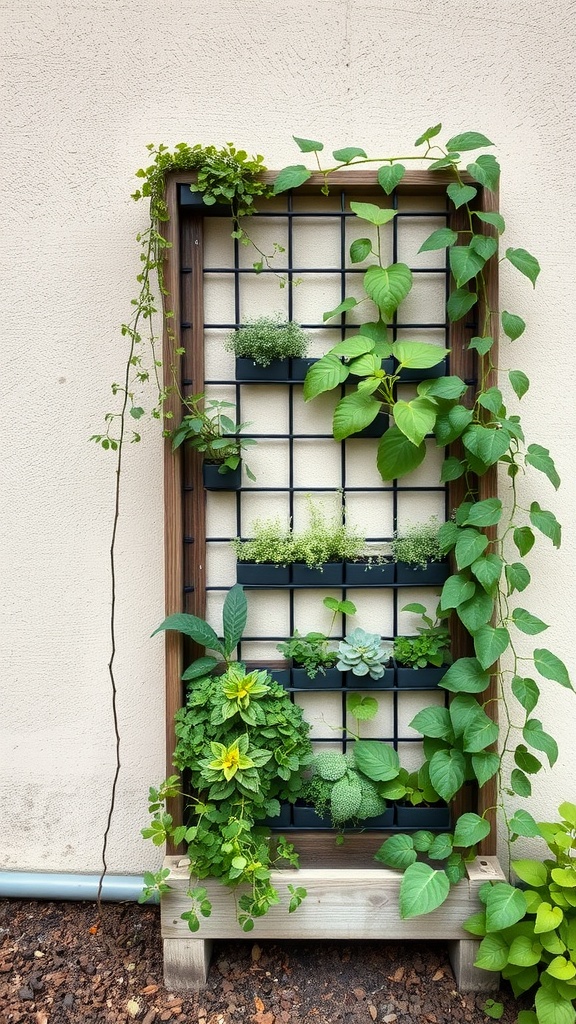
If you’re short on space, vertical raised garden beds are a smart choice. They maximize your available area while allowing you to grow a variety of plants. The image here is a great example of how vertical gardening can work wonders.
This setup features a grid structure that holds several planter boxes. Each box can hold herbs, succulents, or flowering plants, making it versatile. It’s not just about looks; it’s also functional. The vertical design allows for better air circulation and sunlight exposure.
The creeping vines and cascading plants add a beautiful touch, creating a lush green wall. It’s a great way to bring life to a blank space, like a wall or fence. If you have limited ground space, think about going up instead!
Cedar Wood Raised Beds for Rustic Charm
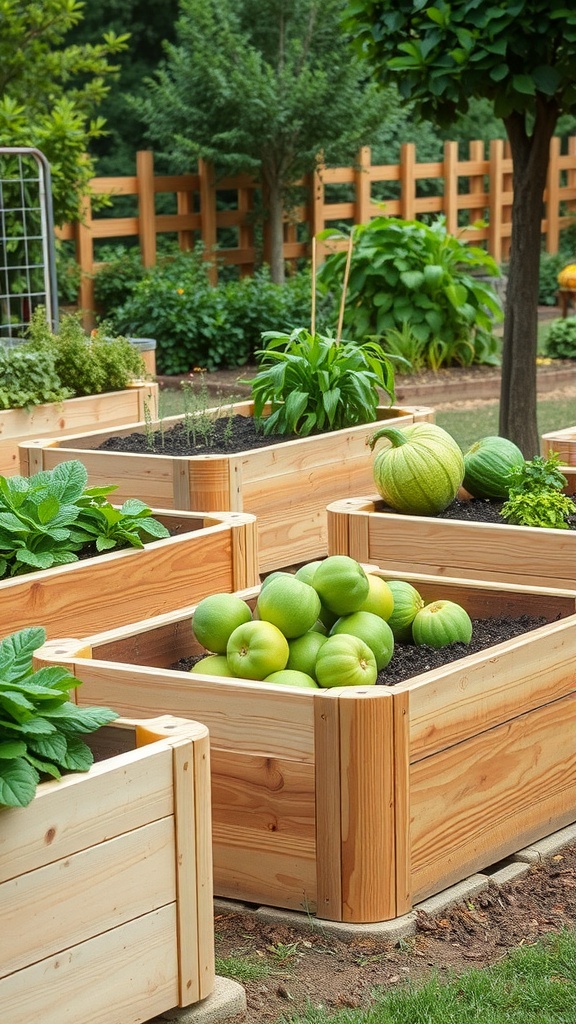
Cedar wood raised beds bring a touch of rustic charm to any garden. The warm tones of the wood complement the vibrant greens of the plants, creating a cozy atmosphere. In the image, you can see several neatly arranged raised beds filled with a variety of plants and vegetables.
The beauty of cedar is not just in its look; it’s also durable and naturally resistant to decay. This means your raised beds can last for years, providing a perfect home for your garden. The way the beds are organized in the image allows for easy access, making gardening more enjoyable.
Notice the healthy green apples and melons sitting in the beds, showcasing the fruits of hard work and care. This setup not only maximizes space but also enhances the aesthetic appeal of your garden. Whether you’re growing herbs, vegetables, or flowers, cedar wood raised beds are a stylish and functional choice.
L-Shaped Raised Garden Bed Design
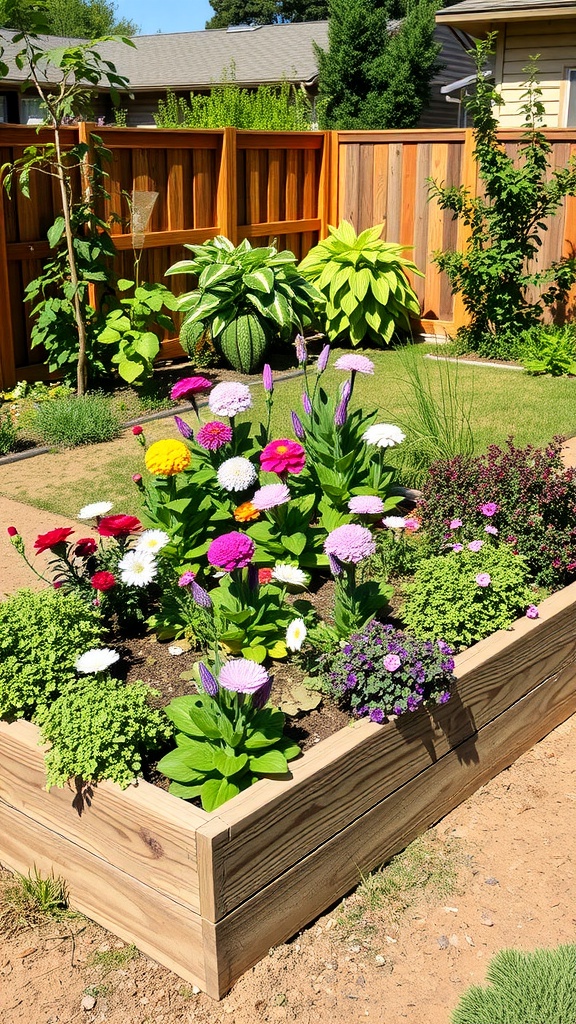
L-shaped raised garden beds are a creative way to maximize space in your garden. They work well in smaller areas while allowing you to grow a variety of plants. This design not only looks neat but also provides easy access from multiple sides, making gardening a breeze.
The image showcases a vibrant L-shaped garden bed filled with colorful flowers and lush greenery. Different plant heights and textures create visual interest. You can see daisies, marigolds, and other blooms peeking out, adding a splash of color to the landscape.
Surrounding the garden bed, the carefully maintained lawn and wooden fence enhance the overall appeal. The setup encourages a welcoming atmosphere, making it a perfect spot to relax or entertain guests. Implementing an L-shaped design can help you create a stunning focal point in your outdoor space.
Tiered Raised Garden Beds for Slopes
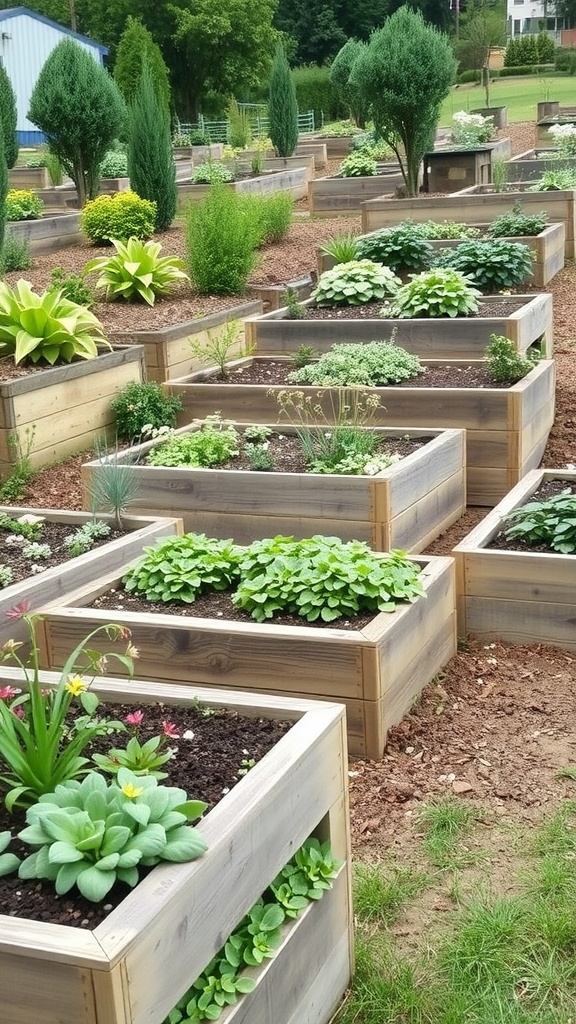
Tiered raised garden beds are a smart solution for sloped areas. They allow you to utilize uneven ground effectively, giving your plants the perfect conditions to thrive. In the image, you can see a series of well-structured beds that create a tiered effect, making them not only functional but also visually appealing.
Each tier is filled with vibrant plants, showcasing a variety of greens and colorful blooms. This layout maximizes sunlight exposure and helps with drainage, which is crucial for the health of your garden. The use of wooden frames gives a rustic touch that blends well with the surrounding landscape.
The design encourages you to grow different types of plants, from herbs to flowering perennials. You can also experiment with spacing and plant heights, creating a lush garden that’s easy to maintain while also being easy on the eyes.
When planning your own tiered garden beds, consider the types of plants you want to include. Growing herbs on the top tier can be a practical choice, while larger plants can occupy the lower levels. This layout not only enhances accessibility but also adds depth and character to your garden.
Companion Planting Layout
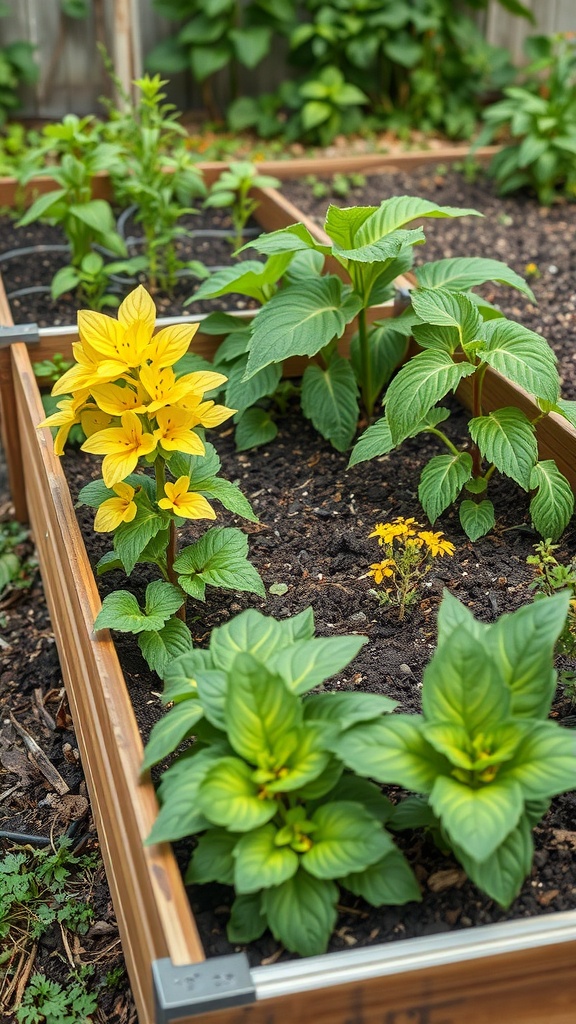
Companion planting is a fun and effective way to maximize your garden’s potential. In the image, you can see a beautiful arrangement of various plants in raised garden beds. The bright yellow flowers stand out, adding a splash of color while serving important roles in the garden.
This layout demonstrates how different plants can complement each other. For instance, the taller plants provide shade for those that prefer a bit of shelter. Meanwhile, the flowers can attract beneficial insects, which help with pollination and pest control.
Incorporating companion planting not only enhances the beauty of your garden but also boosts the overall health of your plants. By mixing herbs, vegetables, and flowers, you create a diverse ecosystem that can thrive together. It’s all about understanding which plants work well in harmony!
So, as you plan your raised garden beds, consider this layout for a colorful and productive space. It’s an enjoyable way to explore nature’s partnerships and enjoy the fruits of your labor.
Square Foot Gardening Layout
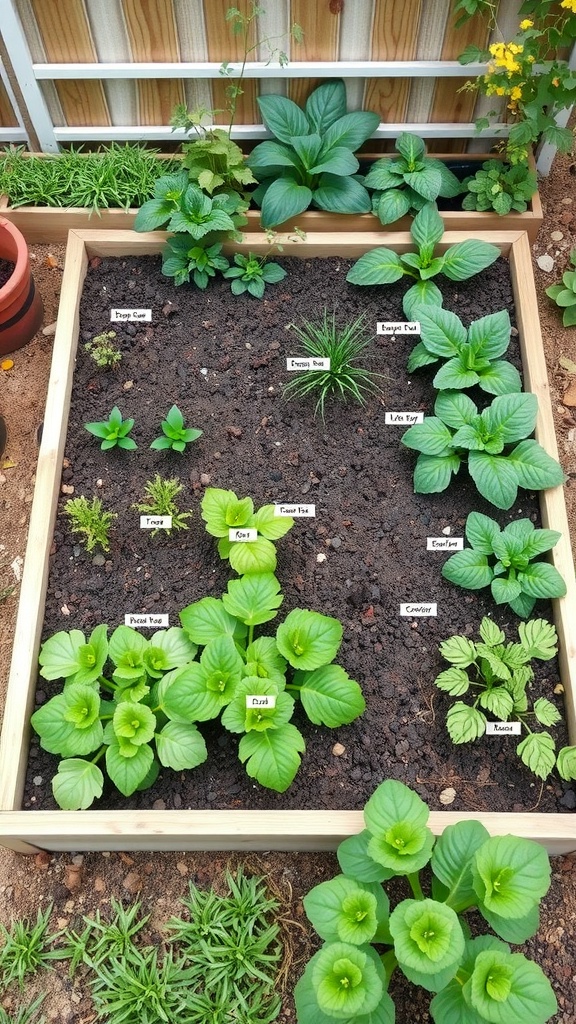
Square foot gardening is a clever way to maximize your growing space while keeping things organized. The layout in the image shows a well-planned garden bed divided into sections, each dedicated to different plants.
You’ll notice various herbs and vegetables carefully labeled, making it easy to identify what’s growing where. This method encourages diversity and allows you to grow more in less space, a win-win for any gardener!
This particular layout includes plants like mint, basil, and different leafy greens, which thrive in close quarters. By utilizing square foot gardening, you can ensure every inch of your garden is put to good use.
Additionally, the layout benefits from easy maintenance. With clear sections, you can quickly see which plants need water or care. It’s a simple yet effective way to create a productive garden.
Hexagonal Raised Garden Beds
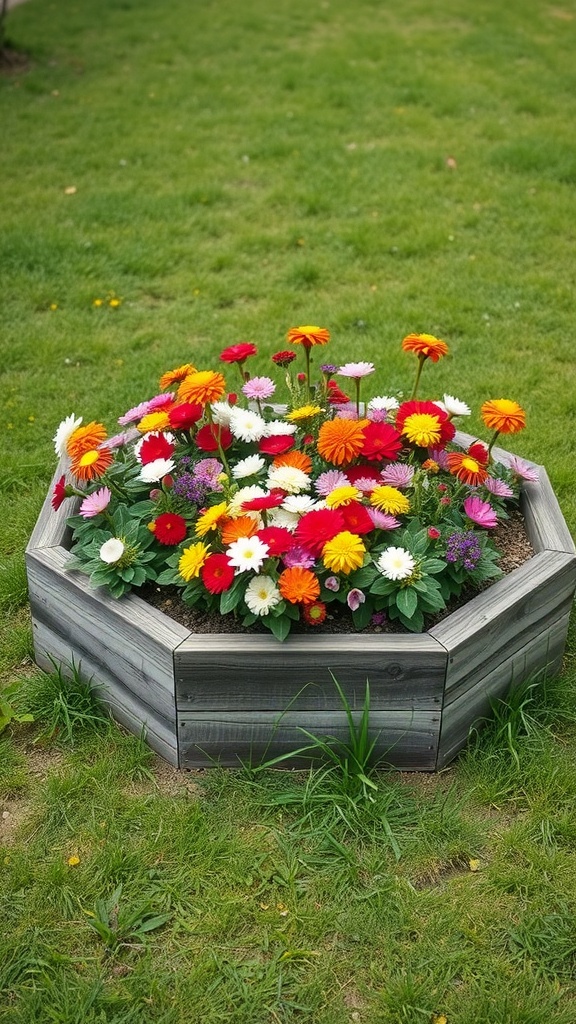
Hexagonal raised garden beds bring a unique shape to your gardening space. Unlike traditional rectangular beds, they offer a more dynamic and visually appealing design. This shape not only enhances the aesthetics of your garden but also allows for better space utilization.
In the image, you can see a beautifully arranged hexagonal garden bed filled with vibrant flowers. The mix of colors, including reds, yellows, and whites, creates a lively focal point in the landscape. This design encourages a variety of plantings, from flowers to vegetables, making it a versatile choice for gardeners.
One of the benefits of hexagonal raised beds is their accessibility. The design allows you to reach plants from multiple sides, making gardening easier and more enjoyable. Plus, the raised structure helps with drainage and soil management, promoting healthy plant growth.
Consider incorporating a hexagonal bed into your garden layout for a fresh and inviting look. It’s a fun way to express your gardening style while also creating a charming space for plants to thrive.
Circular Raised Garden Bed Arrangement
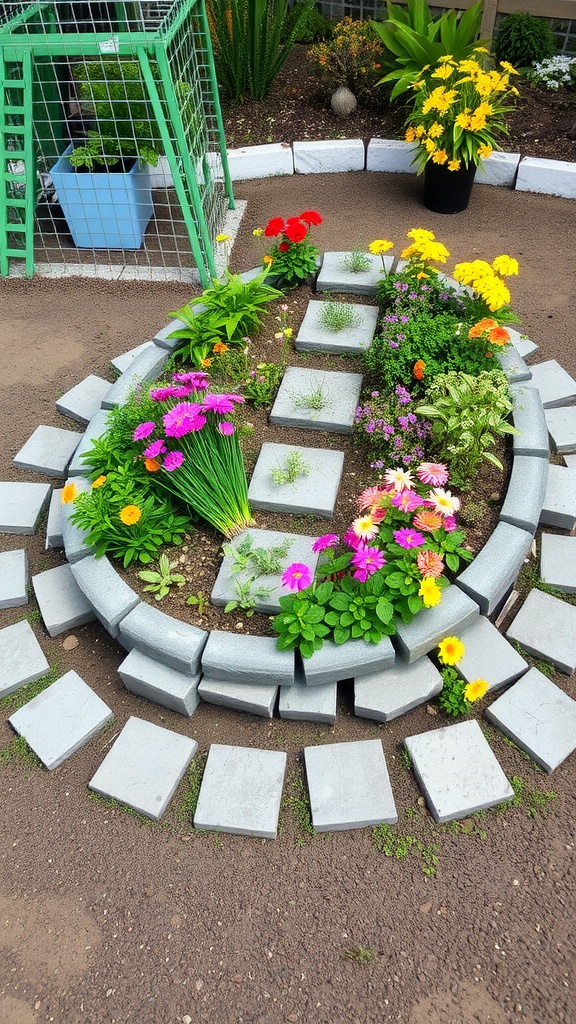
When it comes to designing your garden, a circular raised bed arrangement can add a unique twist. This layout not only optimizes space but also creates an inviting focal point. Picture a circular bed filled with colorful flowers and lush greenery, making it a visual treat.
The image showcases a charming circular raised garden bed. The flowers are arranged in a way that draws the eye inward, creating a sense of harmony. The use of stepping stones surrounding the bed adds both functionality and style, allowing for easy access to the plants.
Consider incorporating various plant heights and colors to enhance the visual appeal. You can mix vibrant flowers with herbs or even some small vegetables. This approach not only makes your garden look lively but also promotes biodiversity.
Additionally, think about the surrounding area. The gravel pathway and potted plants nearby complement the circular design. This layout can transform any garden space into a serene retreat, encouraging you to spend more time outdoors.
Raised Garden Beds with Trellises

Incorporating trellises into your raised garden beds can be a fantastic way to maximize space and support climbing plants. The image shows a vibrant garden with well-structured raised beds, each featuring a trellis. This setup not only keeps the plants organized but also enhances airflow and sunlight exposure.
The trellises in the photo are made of wood, providing an attractive and sturdy support for climbing vines. Plants like beans, cucumbers, and tomatoes thrive when given this kind of support, allowing them to grow vertically. This is especially helpful in smaller gardens where floor space is limited.
Additionally, trellises can add height and visual interest to your garden layout. The greenery climbing up the wooden frames creates a lush backdrop that can make your garden feel more alive. Plus, it’s easier to harvest fruits and vegetables when they’re elevated!
Bordered Raised Garden Beds
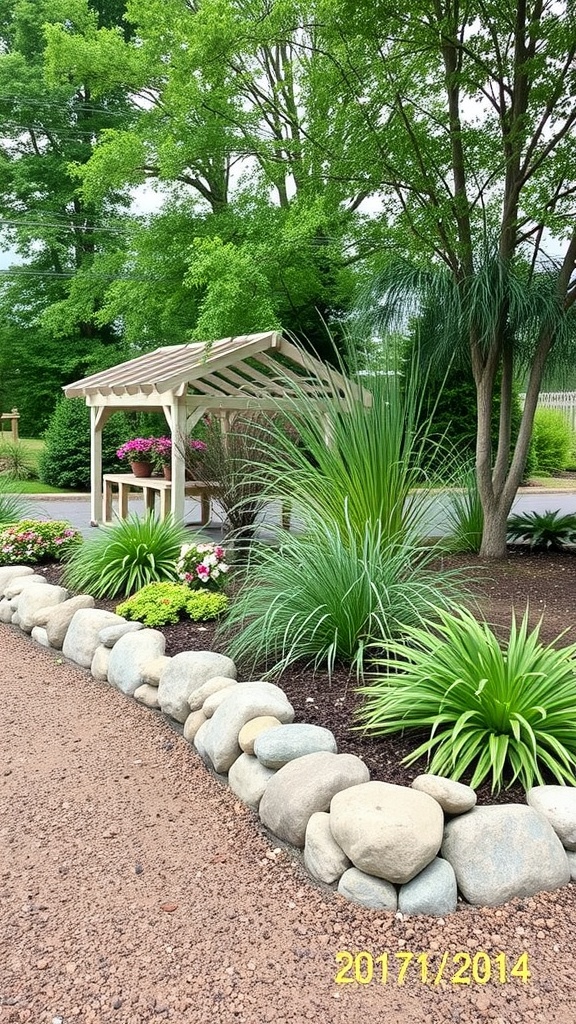
Bordered raised garden beds add a touch of charm and organization to your gardening space. The image showcases a lovely garden area where a stone border defines the planting space. This boundary not only keeps the soil in place but also enhances the aesthetic appeal of the garden.
The use of natural stones creates a rustic look that blends well with the surrounding greenery. In this scene, the vibrant plants and flowers are framed beautifully by the sturdy border, allowing them to stand out even more. It’s an inviting setup that invites you to step in and explore.
Raised garden beds are excellent for growing a variety of vegetables and flowers. They provide better drainage and can be easier on your back when tending to your plants. Plus, with a bordered design, you can easily manage the space and prevent weeds from creeping in.
Taking care of bordered beds can be simple. Regularly check the borders to ensure they’re intact and the plants are thriving. Watering and mulching can help keep plants healthy and the borders looking sharp. With a little maintenance, these bordered raised beds can be the highlight of your garden, creating a lovely environment for both plants and gardeners.
Incorporating Pathways Between Beds
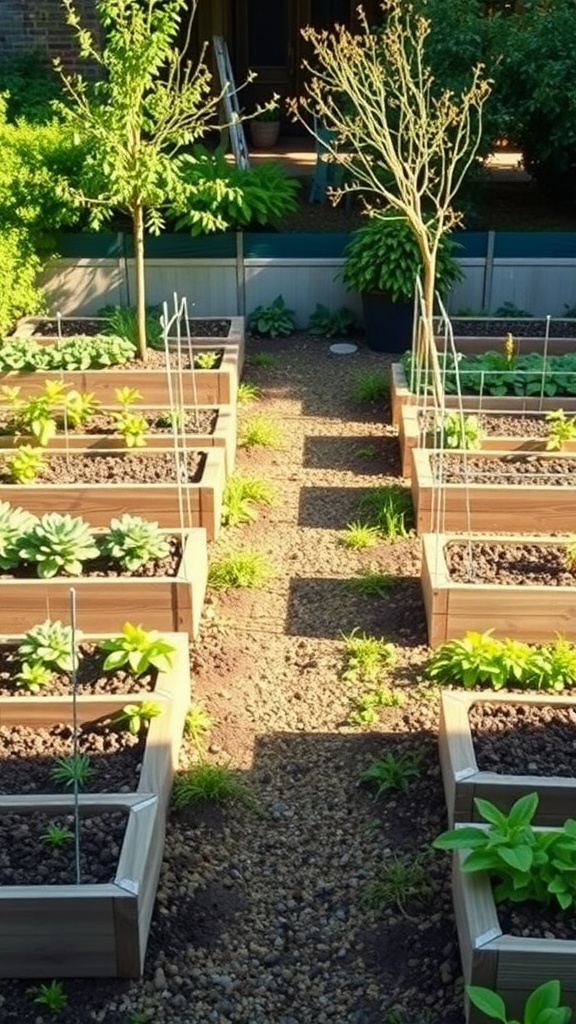
When designing your garden, think about how to make it both functional and inviting. The image above shows a well-planned layout that includes pathways separating raised garden beds. These paths are essential for easy access to your plants while keeping the garden organized.
Incorporating pathways can greatly enhance the overall experience of gardening. They allow you to navigate between your beds without stepping on the soil, which helps maintain its structure and health. Gravel or compacted soil can make for solid, easy-to-walk-on paths, as seen in this image.
By adding pathways, you can also create clear divisions between different types of plants. This not only looks tidy but helps you remember where you planted each type. Plus, it opens up space for companion planting and crop rotation.
Consider the width of your paths. They should be wide enough to easily accommodate a wheelbarrow or your gardening supplies. This layout demonstrates a practical approach, ensuring that everything you need is within reach while you work in your garden.
Don’t forget to include some greenery along the paths! Adding low-maintenance plants or decorative stones can create a lovely ambiance, making your garden a delightful place to spend time.
Rotating Crops in Raised Beds
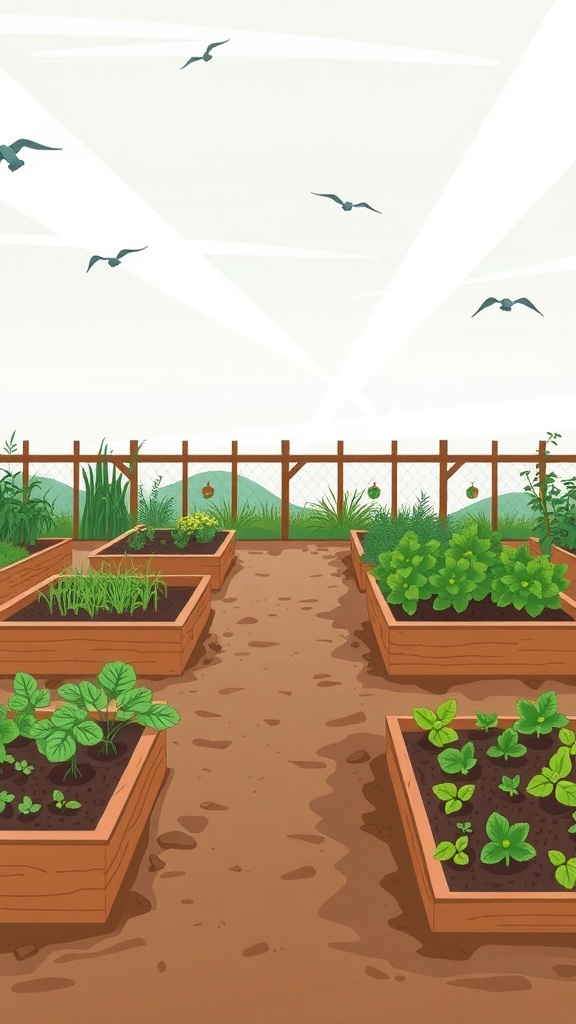
Rotating crops in raised beds is a simple yet effective way to maintain soil health and boost your garden’s productivity. The image shows a well-organized layout of raised beds, each filled with various plants. This approach not only makes the garden visually appealing but also enhances the growth of the plants.
Each raised bed can host different types of crops, allowing for easy rotation each season. For example, you might plant leafy greens in one bed this year and root vegetables in the same bed next year. This strategy helps prevent soil depletion and reduces the risk of pests and diseases recurring in the same area.
The layout in the image gives a clear view of how spaced beds can facilitate crop rotation. By leaving pathways between the beds, you can easily access each one without trampling the soil. This keeps your garden tidy and ensures you can care for each plant effectively.
As you plan your rotation, remember to consider which plants grow well together. Some crops, like beans, can even improve soil fertility for the next planting. Embracing this practice can lead to healthier plants and a more bountiful harvest!
Sunken Raised Garden Beds
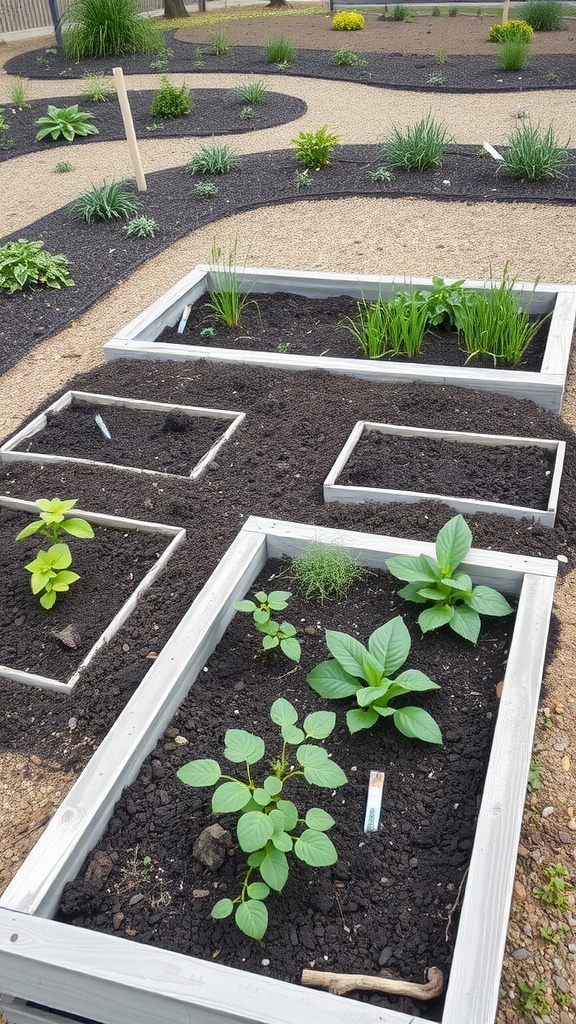
Sunken raised garden beds are an interesting way to create a unique gardening space. In the image, you can see several rectangular beds that are built into the ground, allowing for easy access to plants. This layout not only looks appealing but also has practical benefits.
By placing the garden beds below ground level, you can help retain moisture and create a microclimate for your plants. The depth allows roots to grow more freely, which can lead to healthier plants. This design is especially great for those who may have difficulty bending down to tend to their gardens.
The beds in the image are neatly arranged, with a mix of crops visible, including leafy greens and herbs. This layout encourages organization and makes it easy to manage different plant types. Plus, having defined spaces helps keep weeds at bay.
Surrounding the sunken beds, the gravel and mulch pathways add a nice contrast and help with drainage. This setup encourages a structured yet natural look that enhances the overall garden environment.
Rectangle Layout for Efficient Planting
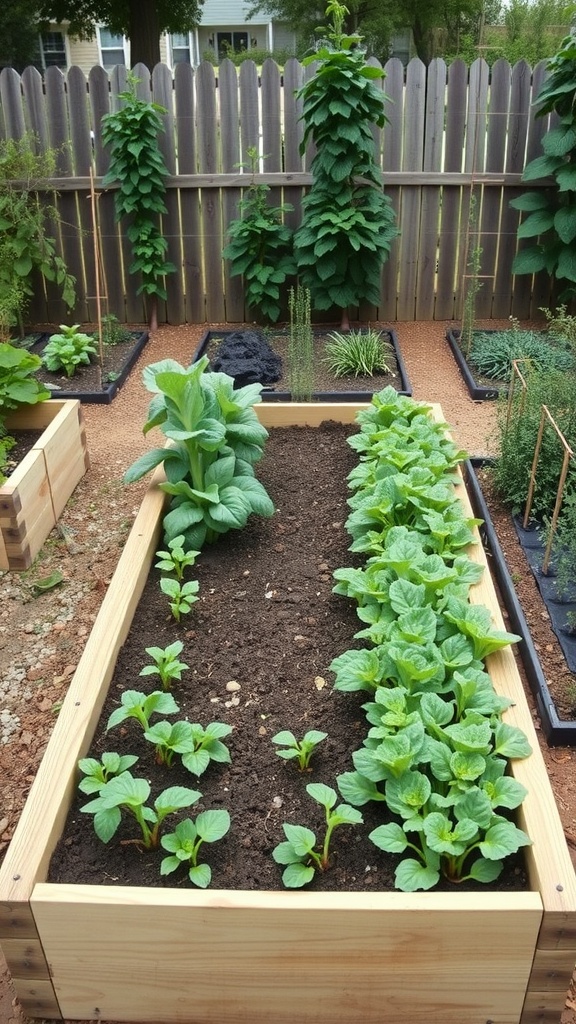
When it comes to raised garden beds, a rectangular layout is often the way to go for those looking to maximize space. This layout allows for organized planting, making it easier to care for your plants. In the image, you can see several rectangular beds filled with lush greenery, showcasing the benefits of this approach.
The beds are designed in a way that promotes healthy growth. Notice how the larger plants are on one side and smaller ones are on the other. This arrangement not only optimizes sunlight exposure but also makes it easier to reach every plant. Keeping taller plants away from the shorter ones ensures that everyone gets their fair share of light.
Additionally, the pathways between the beds are made of gravel, providing easy access for maintenance. This is crucial for tasks like watering, weeding, and harvesting. A well-planned layout like this keeps your garden tidy and functional.
Incorporating vertical elements, like the climbing plants on the fence, adds even more growing space. Using height effectively can lead to a more productive garden where you can grow a variety of vegetables and herbs all in one spot. Overall, a rectangular layout is a smart choice for anyone eager to create a thriving garden.
Multi-Level Raised Garden Beds
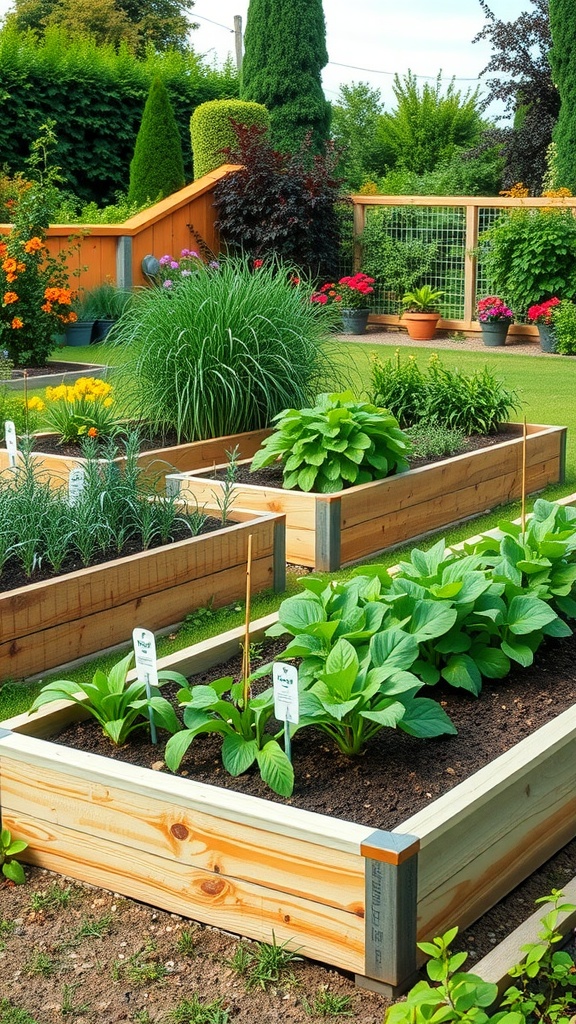
Multi-level raised garden beds offer a creative solution for gardeners looking to maximize space while adding visual interest to their garden. The image beautifully illustrates this concept with several wooden beds arranged at different heights, making the garden not only functional but also pleasing to the eye.
In this layout, the raised beds allow for easy access to plants without the need to bend down too much. This is especially beneficial for those who may have difficulty with traditional gardening methods. Additionally, the varied heights create a sense of depth and dimension, drawing the eye across the landscape.
The plants in these beds seem to thrive, showing an array of leafy greens and vibrant flowers. This layout encourages biodiversity, as different plants can coexist harmoniously. By choosing plants that complement each other in height and growth habits, you can create a lush, productive garden.
Furthermore, multi-level beds can help with water drainage and soil management. Each level can be tailored to different plant needs, allowing for better growth. Overall, this design not only beautifies the garden area but also enhances your gardening experience.
Lattice-Top Raised Bed Designs
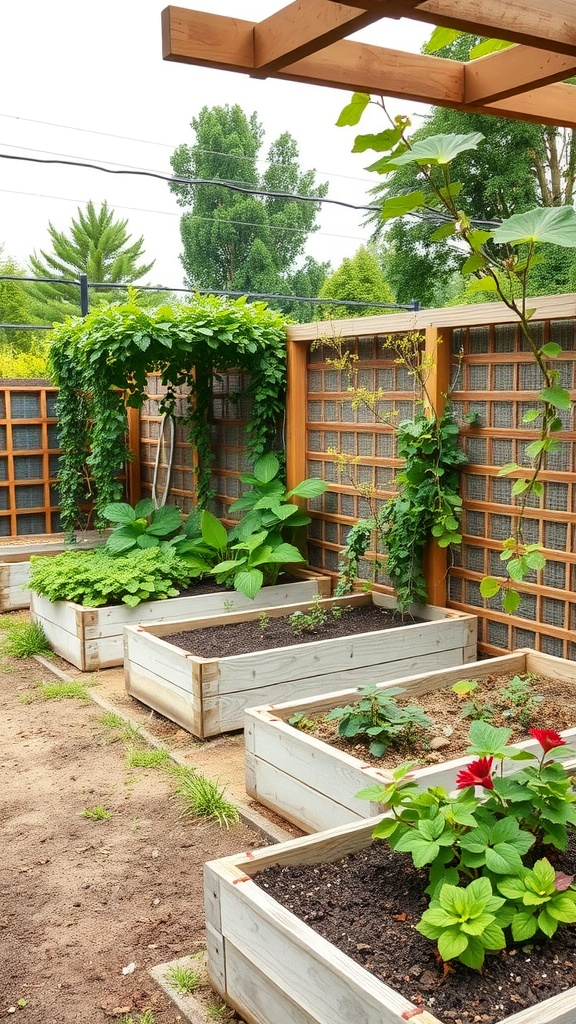
Lattice-top raised beds are a smart choice for anyone looking to add a bit of charm to their garden space. The image showcases a lovely arrangement of raised beds surrounded by a lattice structure that creates a cozy, inviting atmosphere. This design not only beautifies the area but also provides support for climbing plants.
The lattice allows vines and other plants to grow upward, maximizing space and sunlight. This is especially useful for vegetables like cucumbers or peas, which thrive when allowed to climb. The combination of vertical and horizontal growth can make your garden feel more lush and vibrant.
Additionally, the wooden raised beds shown in the image offer a rustic touch that pairs well with the greenery. They provide a clear boundary for your garden while maintaining a natural look. The contrasting textures of the plants against the lattice work create an appealing visual layout.
Using lattice in your raised bed design can also enhance airflow around your plants, which is beneficial for their health. It’s a clever way to combine functionality with aesthetics, making it an excellent choice for anyone passionate about gardening.
Garden Bed Edging with Natural Stone
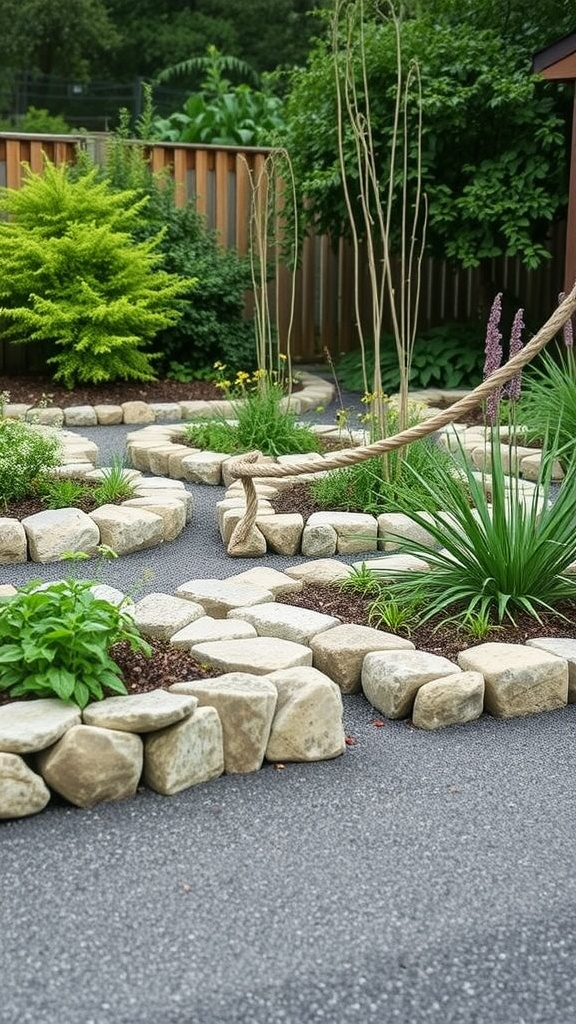
This layout showcases the beauty of using natural stone for garden bed edging. The curved design of the beds creates a soft, inviting look that enhances the overall appeal of the garden. Each stone is uniquely shaped, adding character and charm to the space.
The plants within the beds, including herbs and flowers, are neatly framed by the stones, making the garden feel organized yet lush. The vibrant greenery contrasts nicely with the earthy tones of the rocks, creating a harmonious balance.
To maintain this aesthetic, consider incorporating some low-maintenance plants that thrive alongside the stones. The natural stone edging not only defines the garden beds but also helps retain moisture and prevent weeds, making it a practical choice.
Using natural stones can also create a rustic feel that blends well with various outdoor styles. Whether you prefer a more formal or a casual garden look, this edging option can adapt to your vision.
Contoured Raised Garden Bed Shapes

Contoured raised garden beds can add a unique touch to your outdoor space. These beds often feature soft, flowing shapes that mimic natural landscapes. This design not only enhances aesthetics but also allows for better drainage and plant growth.
The image showcases a series of wavy raised beds, filled with colorful flowers and lush greenery. Each bed is designed with a gentle curve, creating a visually appealing pattern that draws the eye. The variety of plants, from tall grasses to vibrant flowers, adds layers of texture and color.
This type of layout encourages a more organic gardening experience. It allows for easy access to plants while creating distinct areas for different types of vegetation. You can mix herbs, flowers, and vegetables in a way that feels more free-form and natural.
If you’re looking to make a statement in your garden, consider adopting contoured shapes. They not only look inviting, but they also promote healthier plant growth by providing ample space and surface area for roots.
Wooden Pallet Raised Bed Ideas
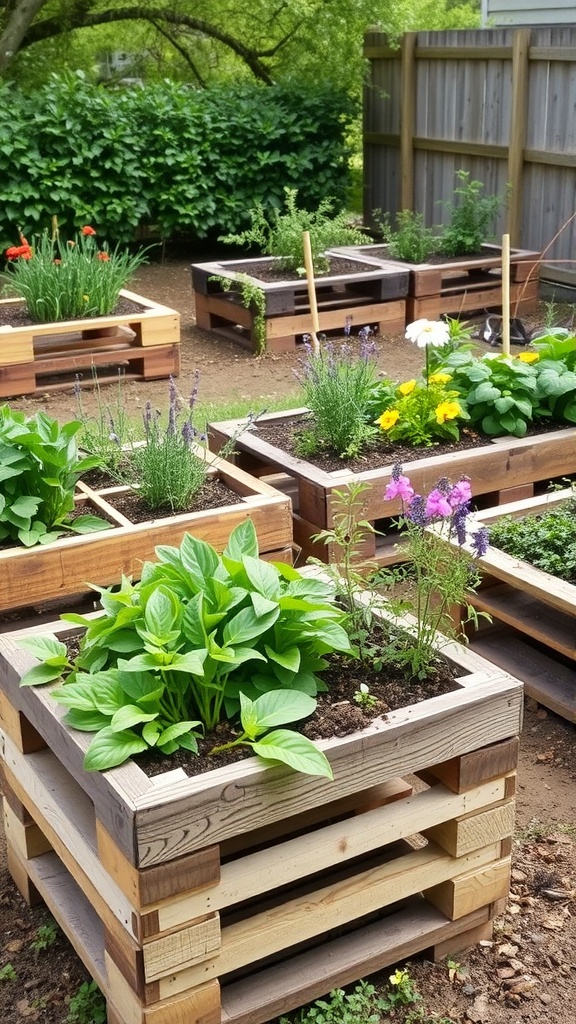
Wooden pallets make a charming and functional choice for raised garden beds. This image shows a delightful arrangement of several pallet beds filled with vibrant plants, showcasing the versatility of using pallets in your gardening endeavors.
The different heights and positions of the beds create a visually interesting layout. You can see an array of herbs and flowers, providing both beauty and practicality. Using pallets allows for easy customization, so you can build beds that fit your space and style.
Another benefit of wooden pallets is their accessibility. They can often be sourced for free or at a low cost, making them a budget-friendly option. Plus, the rustic look of the wood adds a warm touch to your garden.
As you plan your garden, consider mixing different plants in these beds. Combining herbs, flowers, and vegetables not only maximizes space but also attracts beneficial insects. This eco-friendly approach can lead to a flourishing garden.
DIY Recycled Materials Raised Beds

In this section, we explore the beauty and function of raised garden beds made from recycled materials. These beds not only save money but also help reduce waste. They can be crafted from old wood, pallets, or even metal containers. The image above shows a lovely arrangement of raised beds that blend seamlessly into a garden space.
The beds are thoughtfully designed, with a mix of plants that thrive in their cozy environments. The natural look of the wood frames complements the greenery of the plants, creating a warm and inviting atmosphere. You can see how the beds are slightly elevated, making it easy to tend to the plants without bending down too much.
Using recycled materials encourages creativity. You can choose different shapes and sizes to suit your garden layout. This flexibility allows you to make the most of your space while showcasing your personal style. Plus, there’s something satisfying about giving new life to old materials.
Consider using materials like old bricks or stones for the borders, which can add a rustic charm to your garden. You can even paint or stain the wood to match your outdoor decor. The possibilities are endless!
Shade-Loving Plants in Raised Beds

Incorporating shade-loving plants into your raised garden beds is a smart way to make the most of your outdoor space. The image above showcases a beautifully arranged layout where plants thrive in the dappled sunlight beneath the trees. Here, you can see a variety of greens, including leafy vegetables and herbs, all growing happily together.
Raised beds like the ones shown not only offer a neat and organized look but also create an environment that can help protect sensitive plants from extreme weather. These beds are slightly elevated, allowing for better drainage and soil health. You can see plants such as hostas and ferns, which are well-suited for shadier spots, thriving in this setup.
When planning your layout, consider mixing taller plants with shorter ones for visual interest. You might even want to add some decorative elements like stakes or trellises, which can help climbing plants enjoy the vertical space while still staying shaded.
Don’t forget about the importance of soil quality. Adding compost can enrich the soil, providing the nutrients that shade-loving plants need. This ensures that your raised beds remain productive and vibrant throughout the growing season.
Rainwater Harvesting with Raised Beds
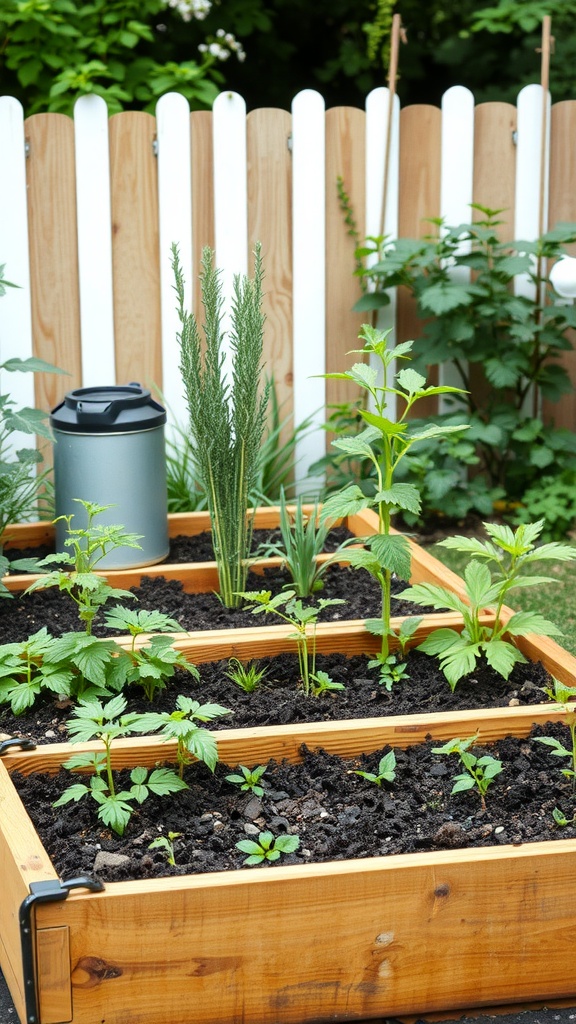
Raised garden beds are not only practical for growing plants but can also be a clever part of a rainwater harvesting system. In the image, we see a beautifully arranged raised bed filled with various plants, showcasing the potential of this gardening method.
The design allows for efficient water drainage, which is essential when collecting rainwater. When it rains, water can flow into the beds, ensuring that your plants get the moisture they need. This setup also helps prevent soil erosion, keeping the nutrients in place.
By strategically placing a rain barrel nearby, you can catch excess rainwater. This can then be used to water your raised beds during drier spells. Not only does this practice conserve water, but it also contributes to a healthier garden.
Incorporating herbs and vegetables, as shown in the image, makes this setup both functional and enjoyable. You can grow fresh produce while being mindful of resource management. Plus, watching your garden thrive while utilizing rainwater feels pretty satisfying.
Herb Spiral Raised Garden Bed
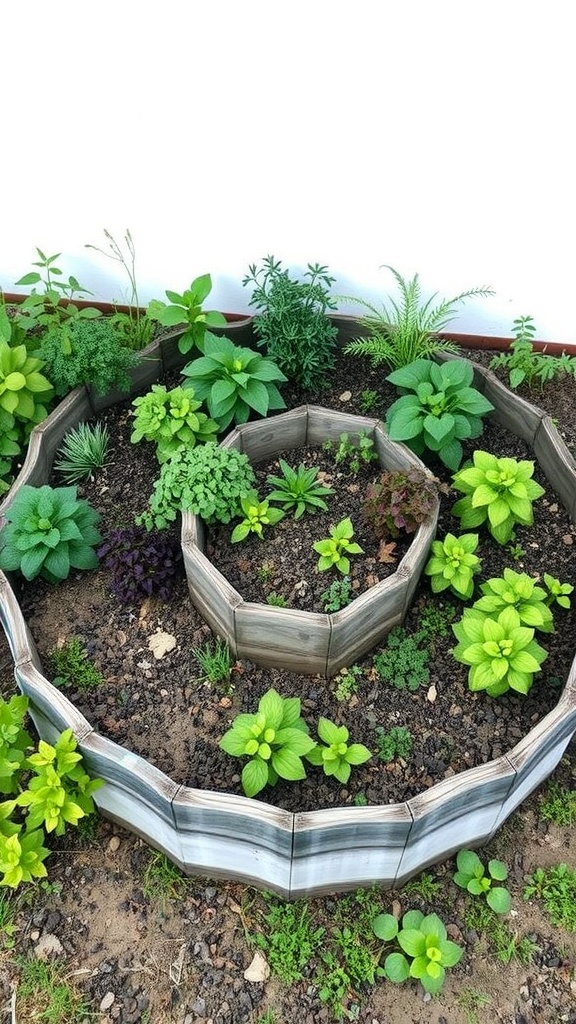
An herb spiral raised garden bed is a fun and creative way to grow a variety of herbs in a compact space. The design features a spiral shape, allowing for different microclimates that can benefit various plants.
In the image, you can see a beautifully arranged herb spiral. The outer rings are filled with a lush assortment of green herbs, making it not only functional but also visually appealing. This layout maximizes space and gives each herb its own unique spot based on sunlight and water needs.
The raised structure helps with drainage and keeps the soil warm, which herbs love. It’s also easier on your back since you won’t have to bend down as much. You can plant favorites like basil, mint, and rosemary, ensuring you have fresh herbs at your fingertips.
This kind of garden bed is perfect for those who might be limited on space but still want to enjoy gardening. Plus, it’s a fantastic way to get kids involved, showing them where their food comes from while having fun!
Edible Flower Gardens in Raised Beds

Edible flower gardens bring a splash of color and a unique twist to your culinary experience. The image showcases raised beds brimming with vibrant flowers, perfect for enhancing your dishes. Plants like zinnias and calendula not only look delightful but can also add flavor and flair to salads or desserts.
Raised beds make it easy to control the soil quality and conditions for your flowers. The neat organization of the beds allows for easy access, making maintenance a breeze. You can see clear labels identifying the different plants, helping you keep track of what you’re growing.
Creating an edible flower garden in raised beds also encourages biodiversity. Flowers attract pollinators, which are essential for the health of your garden. Plus, many edible flowers are beneficial for companion planting, helping to ward off pests naturally.
When planning your layout, consider mixing colors and heights for an appealing aesthetic. A diverse flower garden can be a feast for the eyes and the palate. Enjoying a salad topped with fresh, colorful blooms is a fun way to impress guests or elevate your everyday meals!
Pollinator-Friendly Raised Garden Beds
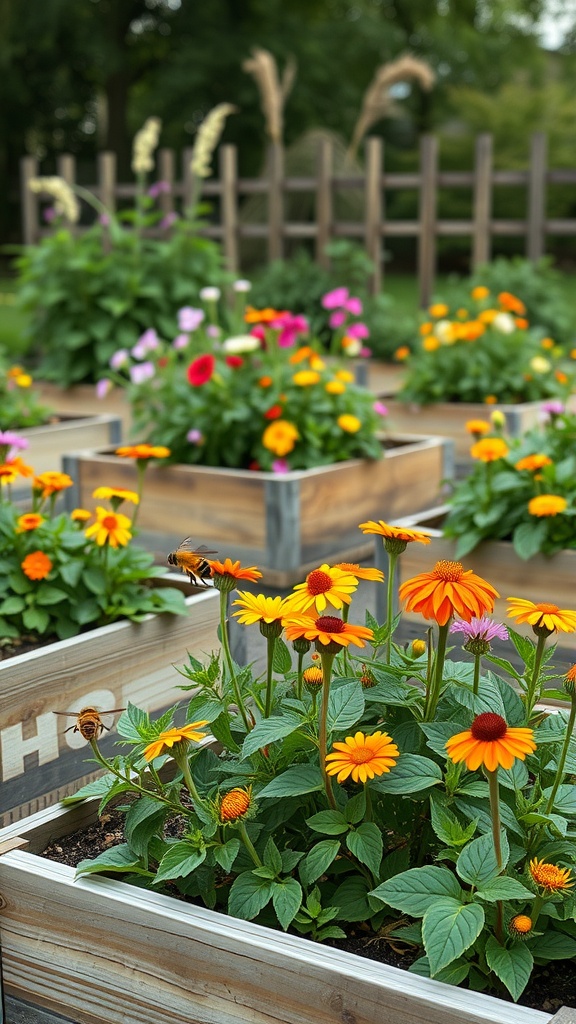
Creating a pollinator-friendly garden is a fantastic way to support local ecosystems while enjoying vibrant blooms. The image showcases raised garden beds brimming with colorful flowers that attract bees and other pollinators. These beds are a perfect example of how to blend beauty and functionality in your garden space.
In the picture, you can see various flowers, including bright orange and pink blooms, that provide essential nectar for bees. The raised beds not only make it easy to care for the plants but also help keep the soil well-drained and healthy. By choosing the right plants, you can create a lively habitat for pollinators.
Consider incorporating native plants, which are often more appealing to local pollinators. Flowers like coneflowers and zinnias thrive in sunny spots and will invite bees to visit. Additionally, a mix of plants that bloom at different times ensures there’s always something in flower throughout the growing season.
With a thoughtful layout, your raised garden beds can become a haven for pollinators. Adding spaces for resting, such as small rocks or logs, can also help create a welcoming environment. Enjoy the benefits of a beautiful, buzzing garden while contributing to the health of your local ecosystem.
Community Garden Raised Bed Ideas
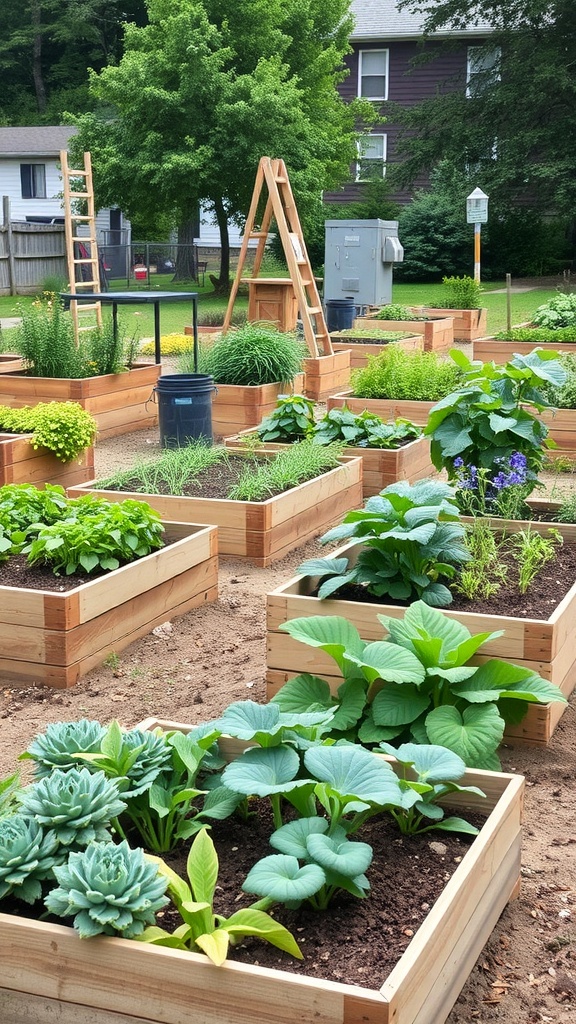
Community gardens are a wonderful space to grow food and foster connections among neighbors. The image shows a vibrant layout of raised garden beds, each filled with a variety of plants. The wooden frames not only provide structure but also create a warm, inviting atmosphere.
In the foreground, you can see lush green plants, including leafy vegetables and flowering herbs. These beds are arranged neatly, allowing easy access for tending to the plants. The layout encourages collaboration, where community members can share tips and even harvest together.
Aside from the beautiful plants, the image highlights practical features like tall ladders for climbing plants and a table for gardening supplies. This setup makes it easy to optimize space while maintaining a friendly and productive environment.
Community gardens can be a source of fresh produce and a hub for learning. They often host workshops on gardening techniques, sustainable practices, and cooking demonstrations, making it easy for everyone to get involved. Whether you’re a seasoned gardener or just starting out, these shared spaces offer plenty of opportunities to connect with nature and your neighbors.
Themed Garden Bed Layouts
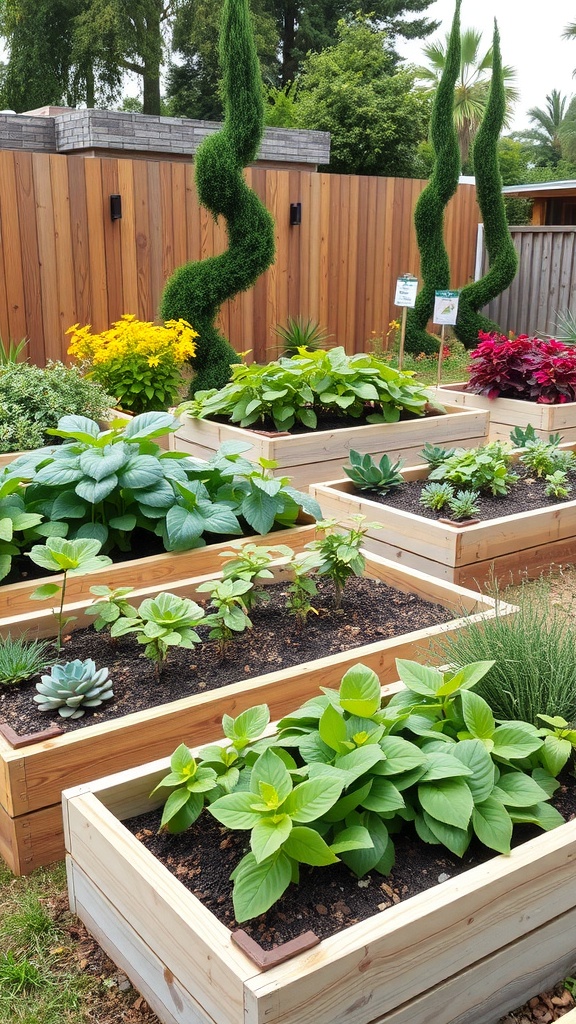
Creating themed garden bed layouts can transform your space into a vibrant oasis. This image shows a beautifully arranged set of raised garden beds brimming with lush greenery and colorful plants. The design draws the eye in, encouraging a closer look at the variety of plants and how they complement each other.
In the foreground, you can see a mix of leafy greens and blooming flowers. The use of various heights and textures creates visual interest. Consider selecting plants that not only thrive in your climate but also fit your chosen theme—be it a herb garden, a flower border, or even a rustic vegetable patch.
Notice how the taller, sculpted greenery in the background adds depth to the layout. This kind of vertical element can enhance any garden bed, making it feel more organized and intentional. Don’t shy away from incorporating ornamental plants alongside your edibles to create a more cohesive look.
The raised beds themselves are made from natural wood, giving a warm and inviting feel. This is a practical choice too, as it can improve drainage and make tending to the plants easier. Whether you’re aiming for a modern aesthetic or a cottage garden vibe, the materials you choose for your garden beds should reflect that.
Ultimately, themed garden beds are a chance to express your personality and creativity. Why not mix in some decorative stones or mulch around the plants to complete the look? The right layout can make your garden not just a place for plants, but a lovely retreat for you and your friends.
